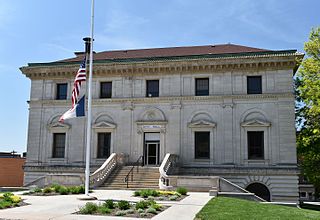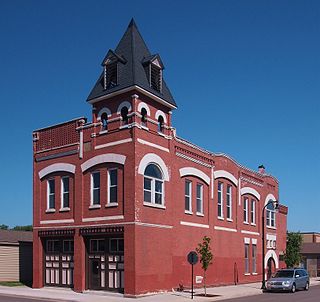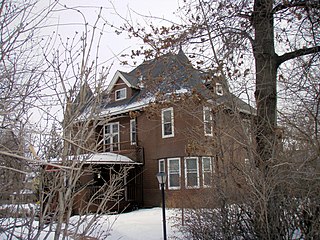
Taylors Falls Public Library is the public library of Taylors Falls, Minnesota, United States, still operating in its original 19th-century building. Originally constructed as a tailor shop in 1854, the building was remodeled and converted into a library in 1887. Taylors Falls Public Library was listed on the National Register of Historic Places in 1970 for its local significance in the themes of architecture and education. It was nominated for being an intact example of small-town libraries as they existed before Carnegie libraries and bookmobiles, and for its Carpenter Gothic/Stick style architecture.

The Pasadena Civic Center District is the civic center of and a historic district in Pasadena, California. The district is roughly bounded by Walnut and Green Streets and Raymond and Euclid Avenues.

The Central Library is the main branch of the Somerville, Massachusetts, public library system. It is located at 79 Highland Avenue, in an architecturally distinguished Renaissance Revival brick building designed by Edward Lippincott Tilton and built in 1914 with funding assistance from philanthropist Andrew Carnegie. The building was listed on the National Register of Historic Places in 1989.

The Charles J. Martin House is a house in the Lowry Hill neighborhood of Minneapolis, Minnesota, United States. The 1903 Renaissance Revival mansion and its grounds are a well-preserved example of an early-20th-century urban estate. The property was listed on the National Register of Historic Places in 1978 for having local significance in architecture.

This is a list of the National Register of Historic Places listings in Faribault County, Minnesota. This is intended to be a complete list of the properties and districts on the National Register of Historic Places in Faribault County, Minnesota, United States. The locations of National Register properties and districts for which the latitude and longitude coordinates are included below, may be seen in an online map.

The U.S. Post Office and Courthouse is a historic post office and courthouse located at Charleston in Charleston County, South Carolina. The building and its annexes serve the federal court for the Charleston Division of the United States District Court for the District of South Carolina. The building was listed on the National Register of Historic Places in 1974.

Nerstrand City Hall is a historic city hall building in Nerstrand, Minnesota, United States, constructed in 1908. It was listed on the National Register of Historic Places (NRHP) on April 6, 1982, for having local significance in the theme of politics/government. It was nominated for being representative of Nerstrand's early growth, and for being Rice County's best example of municipal buildings of the early 20th century.

Ottumwa City Hall is the official seat of government for the city of Ottumwa, Iowa, United States. The building originally served as a post office and federal courthouse. It is part of the Central Park area, which includes: Ottumwa Public Library, Wapello County Courthouse and St. Mary of the Visitation Catholic Church. The building was listed on the National Register of Historic Places in 1976.

The Church of St. Michael is a historic Roman Catholic church building in St. Michael, Minnesota, United States, constructed in 1890. It was listed on the National Register of Historic Places in 1979 for having local significance in the themes of architecture, exploration/settlement, and religion. It was nominated for its status as the dominant architectural feature and the religious and social center of a German Catholic community.

Batchelder's Block is the second-oldest surviving commercial building in Faribault, Minnesota, United States; constructed in 1868. It was listed on the National Register of Historic Places in 1990 for having local significance in the themes of architecture and commerce. It was nominated for its associations with Faribault's early commercial development and the city's emergence as a regional commercial center, and for being a well-preserved example of Faribault's early commercial architecture.

The historic Howard Lake City Hall is a multipurpose government building in Howard Lake, Minnesota, United States, built in 1904. It originally housed the city's government offices, post office, public library, fire department, and public meeting hall. In the 1930s the city began operating a municipal liquor store in the building, which remains the building's primary use today as most other functions have moved to newer facilities. The Howard Lake City Hall was listed on the National Register of Historic Places in 1979 for having local significance in the themes of architecture and politics/government. It was nominated as an example of early-20th-century small-town government architecture, and as Howard Lake's most prominent building.

The original Delano Village Hall is a historic government building in Delano, Minnesota, United States, now in development as the Delano Heritage Center. From its construction in 1888 through most of the 20th century the building housed municipal offices, the police and fire departments, and a public library, while the upper-floor meeting hall was a key venue for public and private events. It was listed on the National Register of Historic Places in 1979 for having local significance in the themes of architecture and politics/government. It was nominated for being a typical example of Minnesota's municipal buildings of the late 19th and early 20th century, and for its longstanding centrality to government and civic functions in Delano.

The former Wadena Fire and City Hall is a historic government building in Wadena, Minnesota, United States, built in 1912. It was listed on the National Register of Historic Places in 1989 for having local significance in the theme of politics/government. It was nominated for being a representative example of early-20th-century civic development and of the municipal buildings common to many small Minnesotan cities. The building now houses a chiropractic clinic.

The City Hall Park Historic District encompasses one of the central economic, civic, and public spaces of the city of Burlington, Vermont. Centered on City Hall Park, the area's architecture encapsulates the city's development from a frontier town to an urban commercial center. The district was listed on the National Register of Historic Places in 1983.

Lake City City Hall is the seat of government for Lake City, Minnesota, United States. It was built in 1899 and later expanded with a large addition. The original section was listed on the National Register of Historic Places in 1981 for its local significance in the themes of architecture and politics/government. It was nominated for being Lake City's most architecturally prominent public building and its longstanding government center.

Appleton City Hall is a historic municipal building in Appleton, Minnesota, United States. It was built in 1895 as one of the few monumental 19th-century buildings in rural western Minnesota. It initially housed Appleton's government offices, fire department, and jail on the ground floor and an auditorium on the upper floor. The city hall was listed on the National Register of Historic Places in 1977 for having local significance in the themes of architecture and politics/government. It was nominated for supposedly being an example of Richardsonian Romanesque architecture and for its long service as a local government and community center. However other sources describe the building's style less specifically as Romanesque Revival, and its municipal services relocated to other facilities in 1976.

The Litchfield Opera House is a community building in Litchfield, Minnesota listed on the National Register of Historic Places for its significance to the community. A committee of businessmen organized in 1899 with the intention of providing a place to hold meetings and theatrical performances. The previous town hall, built in 1871, was obsolete. The government of Litchfield Township, Minnesota paid for construction of the building, which was designed by architect W.T. Towner and built by N.P. Franzen. The city bought the building from the township in 1911. The opera house was listed on the National Register of Historic Places in 1983.

Hibbing City Hall is the seat of local government for Hibbing, Minnesota, United States. It was built in Colonial Revival style in 1922. Hibbing City Hall was listed on the National Register of Historic Places in 1981 for its state-level significance in the themes of architecture and politics/government. It was nominated for being one of northern Minnesota's most architecturally distinctive public buildings and the longstanding seat of government for one of the largest communities of the Iron Range.






























